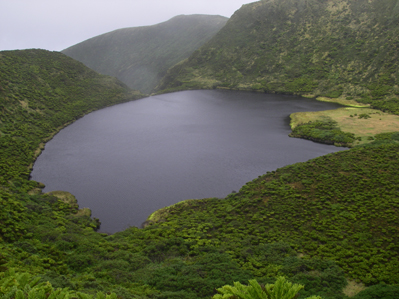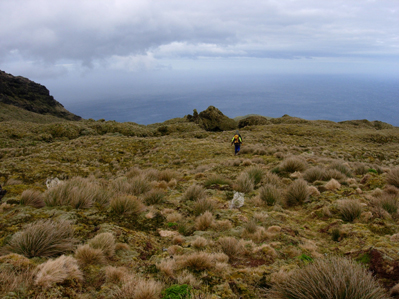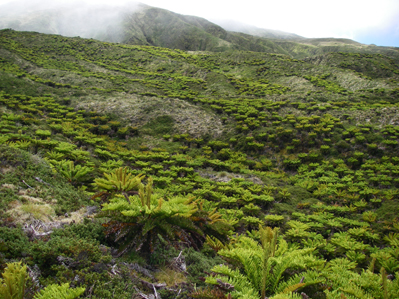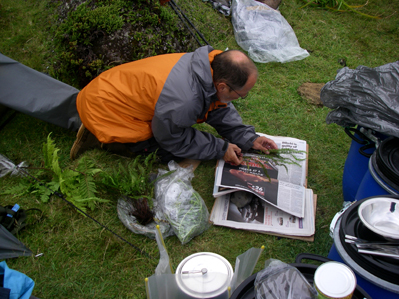


The Tristan da Cunha Island group is situated in the South Atlantic Ocean, midway between the southern tip of Africa (2800 km away) and South America (3300 km away). The nearest land is St Helena, 2100 km to the north. The island group consists of the following islands: Tristan da Cunha (96 km2 in area; 2060 m high), Inaccessible (14 km2; up to 600 m high), Nightingale (4 km2; up to 400 m high) and 300 km south of Tristan da Cunha, Gough Island (65 km2; 910m high).
Of the Tristan group only the main island, Tristan, is inhabited in the sense that it carries a self-sustaining human population of about 275 people. Gough Island has a permanently occupied weather station, with a small complement of meteorologists, which changes each year. The islands are the peaks of volcanoes associated with the Mid-Atlantic Ridge. At 200,000 years old, Tristan is the youngest of the islands, while Nightingale is the oldest: 12 million years. Inaccessible and Gough are 3 to 5 million years old. The climate of the islands is temperate and very oceanic, with a mean air temperature at sea level at Tristan of 15°C, with relatively small daily and seasonal variation. On Gough it is a few degrees colder. Rainfall is high: 1700 mm annually at the Tristan Settlement, and 3300 mm at Gough. Strong winds are common. Mean wind speed is about 40 km/h. Wind speed increases strongly with altitude, while temperature decreases. Thus, while the lowlands experience quite pleasant weather, the uplands may be covered in snow or battered by gale force winds.
The vegetation
The coastal fringes of the islands - in the case of Nightingale Island this is practically the whole island - are covered by vegetation of large tussock-forming grasses, Spartina arundinacea, and - on Gough - Poa flabellata. These tussock-communities reach up to 300 m above sea level, and are typical for areas with influence of windblown saltspray and of nutrient input by seabirds. On Tristan this type of vegetation covered the lowlands before human settlement, but now has disappeared as a result of grazing. It may also have been affected by the reduction in nutrient input as a result of greatly diminished seabird numbers due to predation by rats, and in the past by cats, pigs and other introduced mammals. Above the tussock grasslands follows a zone where saltspray influence is small, and nutrient input by birds relatively low, with a mosaic of Phylica arborea woodland and fernbrake communities.
The Phylica woodland is dominated by the island tree (Phylica arborea, up to 4 m high), with many ferns, grasses and sedges in the undergrowth. On Tristan Phylica woodland can be found on the slopes going up to the Base, up to about 500 m high. On Gough the altitudinal limit of the community is about 400 m. In the lowlands of Tristan Phylica woodland has disappeared, again as a result of grazing, as well as by trees being used for fuel. Part of the lowlands away from saltspray influence is covered by fernbrake communities, dominated by species of Histiopteris, Blechnum or Elaphoglossum.
Fernbush plant communities dominated by the endemic tree-fern Blechnum palmiforme intermingle with fernbrak communities in the upper parts of this zone. On Tristan these communities occur in the lower parts of the Base, from 300 to 800 m and on Inaccessible they cover a large part of the central plateau. On Gough these fernbush and fernbrake communities are restricted to lowlands and sheltered valleys from 50 to 350 m altitude.

The vascular plants of the islands are reasonably well known, but information on the distribution and abundance of many of the native species within the islands is very incomplete. Some 53 species of flowering plants are native to the Tristan da Cunha Islands, as well as 38 ferns and clubmosses. Of the native flowering plants, 28 species, as well as 4 varieties or subspecies are endemic i.e. they do not occur anywhere outside these islands. For the ferns and clubmosses the number of endemic species is 15, plus 2 endemic varieties. This means that over half of the native vascular flora of the islands is restricted to these tiny specks of land, and is not found anywhere else. Seven of these endemics are known only from a single island of the group, most of them from Gough.
In addition to the native plant species a large number of plants from elsewhere have been introduced, by accident or on purpose. On the main island some 150 introduced species occur, completely transforming the vegetation in large parts of the island into alien dominated communities. This transformation process is greatly enhanced by the introduced grazing mammals (cattle and sheep). On the outer islands the number of introduced species is much smaller than on the main island, but their impact locally is quite devastating. On Gough, for instance, only 18 alien plant species are present, but two of these, Yorkshire fog (Holcus lanatus) and creeping bent (Agrostis stolonifera), have completely transformed the vegetation along watercourses and ponds, and native species are now very rare in these habitats.
Alien plants and animals pose the main threat to the island's flora.

Conservation is taken very seriously in the islands. Gough and Inaccessible islands have been designated a World Natural Heritage Site, and conservation measures, such as restrictions in the harvesting of native wildlife, are in place elsewhere. With half the vascular flora of the islands occurring nowhere else on the world, and the number of invasive plants (and presumably invertebrates as well) still increasing at a rate of roughly one newly introduced species every 8 months, it is of vital importance that measures are taken to conserve the unique species and communities found across the territory.
Please use the links below to see further details on conservation activities in the UK Overseas Territories.
British Indian Ocean Territory
South Georgia and the South Sandwich Islands
Sovereign Base Areas on Cyprus
Homepage of the UKOTs Online Herbarium



